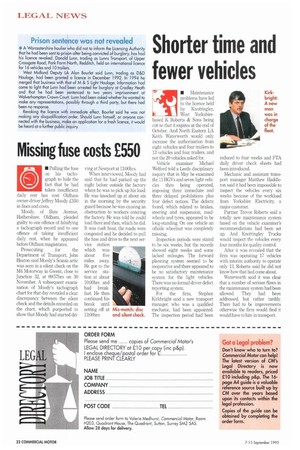Shorter time and fewer vehicles
Page 24

If you've noticed an error in this article please click here to report it so we can fix it.
• Maintenance problems have led to the licence held by Knottingley, West Yorkshireiased K Roberts & Sons being cut so that it expires at the end of October. And North Eastern LA Keith Waterworth would only increase the authorisation from eight vehicles and four trailers to 13 vehicles and four trailers, and not the 20 vehicles asked for.
Vehicle examiner Michael Welford told a Leeds disciplinary inquiry that in May he examined the 11 HGVs and seven light vehicles then being operated, imposing three immediate and three delayed prohibitions plus four defect notices. The defects found, which related to brakes, steering and suspension, roadwheels and tyres, appeared to be long-standing. On one vehicle an offside wheelnut was completely missing.
Inspection periods were stated to be six weeks, but the records showed eight weeks and some lacked mileages. The forward planning system seemed to be inoperative and there appeared to be no satisfactory maintenance system for the light vehicles. There was no formal driver defect reporting system.
For the firm, Stephen Kirkbright said a new transport manager, who was a qualified mechanic, had been appointed. The inspection period had been reduced to four weeks and FTA daily driver check sheets had been introduced.
Mechanic and assistant transport manager Matthew Haddleton said it had been impossible to inspect the vehicles every six weeks because of the workload from Yorkshire Electricity a major customer.
Partner Trevor Roberts said a totally new maintenance system based on the vehicle examiner's recommendations had been set up. And Knottingley Trucks would inspect the vehicles every four months for quality control.
After it was revealed that the firm was operating 17 vehicles with interim authority to operate only 13, Roberts said he did not know how that had come about.
Waterworth said it was clear that a number of serious flaws in the maintenance system had been allowed. They had been addressed, but rather tardily. There had to be improvements otherwise the firm would find it would have to hire in transport.
















































































































